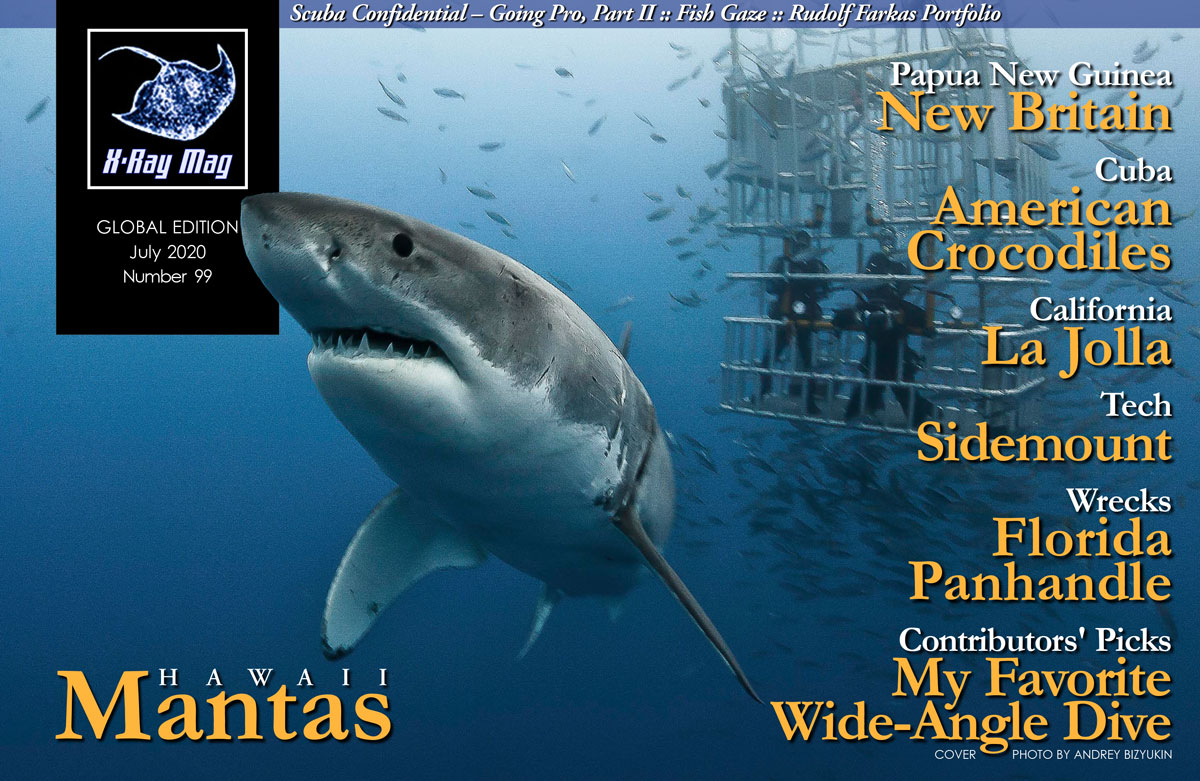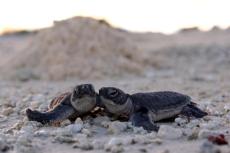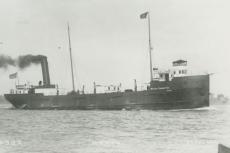While Florida’s eastern coast certainly offers countless popular wreck dives, the Panhandle is an often-overlooked gem. The Florida Panhandle Shipwreck Trail provides an enjoyable mechanism for divers to experience the history and heritage the Gulf of Mexico has to offer within the realm of wreck diving.
Contributed by
Divers understand there is something eerily attractive about a ship laying upright on the seafloor. Wreck divers often chase that feeling of curiosity and wonder when exploring undersea environments.
The Trail was launched in 2012 by the Florida Bureau of Archaeological Research (BAR) in response to the 2010 Deepwater Horizon oil spill, which caused a dramatic drop in tourism to the Panhandle. BAR brainstormed creative ways to boost the economy, especially where diving and tourism were concerned. Local waterfront communities expressed a need for a diving trail similar to the Florida Keys Wreck Trek located on the eastern coast.
A lengthy data collection process resulted in the selection of 12 wreck candidates, which were accessible to a variety of certification levels, contained abundant marine life and had plenty of superstructure to explore. The wrecks, which were situated offshore of Pensacola, Destin, Panama City and Port St. Joe, were popular within local communities and succeeded in attracting tourists to the region.
Continued management and promotion of the Trail involved the creation of a website and Facebook page, installation of billboards, distribution of printed material and production of high-quality, promotional video footage. The videos were produced in the summer of 2018 and contained cinematic interviews with archaeologists, who highlighted various exciting aspects of the wrecks. As a result of these widely distributed and extremely popular videos and other promotional materials, the Trail received an uptick in interest in 2019. In response, local stakeholders expressed a desire to have more wrecks included in the Trail. So, by the summer of 2020, BAR plans to add eight more vessels to the Trail. Here, the 20 vessels are spotlighted.
Pensacola
Three Coal Barges. These barges broke free from their transport in 1974 while on their way to a designated offshore artificial reef location. To prevent them from washing ashore or causing damage to other vessels, the US Navy sent in its demolition experts to plant explosives on the runaway barges, effectively sinking them in their present location. The barges rest in 50ft (15.3m) of water and offer plenty of opportunities to practice novice dive skills and enjoy local marine life.
San Pablo. Nearby is San Pablo, a freighter that originally transported fruit from South America to Boston. The vessel saw action during World War II when it was attacked by a U-boat and sank off Costa Rica. It was refloated and transported to the Gulf of Mexico, where it was eventually blown up in a secret military operation off Pensacola in 1944. Found at a depth of 80ft (24.4m), this freighter invites divers to consider its intriguing story and history as they explore its boilers, rudder and refrigeration coils.
Pete Tide II. Continuing farther offshore is Pete Tide II, an offshore oil rig supply ship that carried laborers and provisions to various rigs in the Panhandle. The 166ft (50.6m) long vessel was sunk upright in 100ft (30.5m) of water in 1993. The pilot house and other two decks offer entertaining swim-throughs, with plenty of schooling fish and other marine life.
YDT-14. YDT-14 is close enough to Pete Tide II that these dives are often paired. YDT-14 was a US Navy dive tender vessel in service in the Caribbean and South Atlantic during the 1940s. This workhorse was sunk as an artificial reef in 2000 in 100ft (30.5m) of water. The upright structure is similar to Pete Tide II, with an intact pilothouse and intriguing swim-throughs.
USS Oriskany. The final and farthest offshore wreck in this area is USS Oriskany, which is quite possibly the most impressive and popular dive site off Pensacola. The largest artificial reef in the world, it served as an aircraft carrier during World War II. The 911ft (277.7m) vessel served in the Pacific Theater, receiving battle stars for its service in the process. It was ultimately repurposed as an artificial reef in 2006 and rests at a depth of 212ft (64.6m). This immense vessel rises to 80ft (24.4m), offering plenty of structure for divers to explore.
Fort Walton Beach & Destin
Tugboats. The Fort Walton Beach and Destin areas of the Panhandle are a hot spot for purposefully sunk tugboats. Miss Louise was an original 2012 Trail inclusion, but five more tugs were added in 2020.
At a depth of 60ft (18.3m), Miss Louise is perfect for novice divers. The 95ft (30m) tug maintains a resident sea turtle and schools of bait fish, which swarm and dance around visitors.
Tugboat “Zuess,” Mohawk Chief, Chepanoc, Belize Queen/Bob Reay Reef, and M/V Janet complete the tugboat highlight in this area. Many of these tugs are associated with concrete and steel artificial reef structures, which add to the diver’s underwater experience.
Thomas Hayward. Another 2020 addition in this area is the Destin Liberty Ship, also known as Thomas Hayward. History enthusiasts will appreciate a visit to this World War II Liberty Ship, which was active until 1949 and transported allied troops from the United States to Europe.
Panama City Beach
Panama City Beach contains a number of wartime vessels that now serve as artificial reefs.
Service tugs. The USS Chippewa and USS Accokeek were initially service tugs in the 1940s before being used as navy training vessels. Chippewa was sunk in 1990 in 100ft (30.5m) of water. Accokeek was also sunk in 100ft (30.5m) of water, in 2000. Both vessels are intact enough for swim-throughs, and Accokeek has a resident goliath grouper.
USS Strength. USS Strength was a World War II minesweeper that fought in the Pacific Theater, where it found itself in the crosshairs of a midget submarine and a kamikaze raid. Surviving both, the vessel was eventually sunk off Panama City in 1987. This vessel is not as intact as other wrecks included in the Trail, but it offers an exciting dive for history buffs and marine life enthusiasts alike.
Black Bart. Black Bart was another offshore oilfield supply vessel that served the Gulf of Mexico. Originally named Vulcano de Gulfo, the vessel was sunk as an artificial reef in 1993 in memory of Navy Supervisor of Salvage Captain Charles “Black Bart” Bartholomew. The vessel’s wheelhouse was ripped off completely after Hurricane Michael in October 2018, but the open cargo hold still offers swim-through opportunities.
FAMI Tugs. The FAMI Tugs also illustrate the power of Mother Nature. Originally, these two deliberately sunk tugs were situated bow to bow, but after a strong storm, one boat was deposited slightly atop the other.
El Dorado. The final vessel in this area, El Dorado, is a 2020 addition that provides yet another reminder of Florida’s long history with the destructive forces of hurricanes. The unique and quite recently deployed ship was a modern luxury cruise liner that washed ashore in October 2018 after the devastating Hurricane Michael. Its owner donated it as an artificial reef, allowing the community to reap the benefits for years to come, much to the enjoyment of divers and marine life alike, illustrating how an unfortunate situation can lead to opportunity and positive outcomes.
Port St. Joe
History enthusiasts will appreciate the final two wrecks, Vamar and Empire Mica, which were not deliberately sunk as artificial reefs.
Vamar. Off Port St. Joe lies Vamar, an English-built patrol gunboat. The steamer originally served as a support vessel during Admiral Richard Byrd’s 1928 Antarctic expedition before it sank in 1942 under mysterious conditions. Resting in only 25ft (7.6m) of water, this shallow dive offers visitors a chance to experience a real shipwreck scattered across the seafloor, a fascinating juxtaposition to those intact and upright vessels described previously.
Empire Mica. Empire Mica, a 2020 addition, is accessible via Port St. Joe, Mexico Beach, or Panama City. This British tanker carried fuel for the Royal Air Force during World War II before it was torpedoed by a German U-boat 21mi (33.8km) south of Cape San Blas. While much of the upright structure has since deteriorated due to time and Coast Guard test bombing, the wreck offers a fascinating story and draws many divers to this area. It also serves as a reminder of how close the war was to America’s shores.
Submerged cultural resources
These structures on the Florida Panhandle Shipwreck Trail represent the brilliance of the Panhandle community in creating unique solutions to a challenge. Most of the vessels included in the Trail were sunk intentionally as artificial reefs because the Gulf of Mexico does not contain the natural reef structure present on Florida’s eastern coast. These wrecks-turned-reefs also preserve aspects of Florida’s fascinating maritime history, allowing them to continue telling their stories with a renewed life and duty. Because they are pivotal to the marine environment and economy, the vessels illustrate why it is important to preserve and protect submerged cultural resources and underwater environments. Those who observe these vessels in person realize their greater importance and become stewards of their long-term preservation.
Through the Trail, we are reminded to “take only pictures, [and] leave only bubbles.” The Florida Panhandle Shipwreck Trail is the synthesis of recreational, ecological and heritage tourism and promotes responsible visitation to and management of artificial reefs and historic wrecks. The Emerald Coast invites you to make your own memories on the Florida Panhandle Shipwreck Trail. ■
For more information, please visit: floridapanhandledivetrail.com. Or follow on Facebook at: facebook.com/FloridaPanhandleShipwreckTrail.
Melissa R. Price is an American underwater archaeologist based in Florida. She specializes in Spanish Colonial shipwrecks and submerged archaeological sites of the Archaic period. She is a PADI Open Water Scuba Instructor, Diving Safety Officer and PhD candidate at Leiden University in the Netherlands.



















































